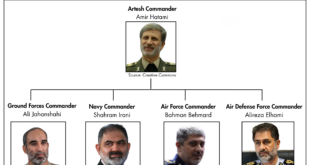TEHRAN (Agencies) — A gathering of Iranians who claim they are dedicated to becoming suicide bombers warned the United States and Britain on Saturday of attacks on coalition military bases in Iraq if there were a strike against Tehran’s nuclear facilities.”With more than 1,000 trained martyrdom-seekers, we are ready to attack the American and British sensitive points if they attack Iran’s nuclear facilities,” said Mohammad Ali Samadi, spokesman of Esteshadion (Martyrdom Seekers).
“We have registered more than 52,000 people who willingly are ready to defend their country.” “If they strike, we have a lot of volunteers. Their [US and British] sensitive places are quiet close to Iranian borders,” Samadi said after a gathering of about 200 students for a seminar on the suicide-bombing tactics at Tehran’s Khajeh Nasir University.
Samadi reviewed the history of the suicide bombing as a weapon, praising it as the most effective Palestinian tactic in their confrontation with Israel.
The organisers also showed video clips of suicide attacks against Israelis, including one in the Morag settlement near Rafah in Gaza Strip in February 2005. One settler, three Israeli soldiers and the two attackers were killed in the attack.
Hasan Abbasi, the main speaker also praised suicide-bombers, but denounced attacks against “innocent people as Al Qaeda did in New York.” Abbasi told the audience of potential martyrs that Iran was not seeking nuclear weapons as claimed by the United States and some of its allies. “Our martyrdom-seekers are our nuclear weapons,” said Abbasi, a university instructor and former ranking in the elite Revolutionary Guards.
After his speech, about 50 students filled out membership applications.
“This is a unique opportunity for me to die for God, next to my brothers in Palestine. That was why I signed up,” said Reza Haghshenas, 22, an electrical engineering student.
A 23-year-old woman student, Maryam Amereh, said: “We are trying to defend Islam. It’s a way to draw the attention of others to our activities.” But Rahim Hasanlu, a 22-year-old industrial management student, sipped his orange juice and declared himself not interested in joining. “I just attended to learn what they’re saying, thats all.” Esteshadion was formed in late 2004, calling for members on a sporadic basis at Friday prayer ceremonies, state-sponsored rallies and at the group’s occasional meetings.
Those who join have three choices: To train for suicide attacks to defend Iran’s national interests, for suicide attacks against Israel or the assassination of British author Salman Rushdie, who was sentenced to death by former Iranian leader Ayatollah Ruhollah Khomeini for his 1989 book, “Satanic Verses.”
On Saturday, Iran said a reported proposal by the head of the UN’s nuclear watchdog for the Islamic republic to be allowed to conduct small-scale uranium enrichment work was a “step forward.”
Diplomats have said the director of the International Atomic Energy Agency, Mohammad Al Baradei, has warned in quiet diplomacy that it will be hard to strike a compromise in the mounting crisis unless Iran can conduct limited fuel work.
ElBaradei has reportedly said a deal could hinge on letting Iran operate a pilot enrichment plant while also giving guarantees not to conduct industrial-scale enrichment. “We regard this proposal as an indication of accepting enrichment in Iran and a step forward,” Foreign Minister Manouchehr Mottaki was quoted as saying by the official news agency IRNA.
“We have two main aims in nuclear negotiations: one is to clear some countries’ concerns by giving the required guarantees about the peaceful nature of the Islamic Republic of Iran’s nuclear activities, the second is to obtain Iran’s legitimate rights which is having peaceful nuclear technology.”
Quake hits southern province
TEHRAN (AFP) — A powerful earthquake registering 5.3 on the Richter scale hit southern Iran on Saturday, injuring nine people and causing some material damage, official media said.
The quake hit an area in Kerman province between the towns of Rafsanjan and Anar, situated around 600 kilometres southeast of the capital Tehran.
The official news agency IRNA said the injured were in a “satisfactory” condition.
Iran sits astride several major faults in the earth’s crust, and is prone to frequent earthquakes.
In November, a quake measuring at least 5.9 on the Richter scale struck the island of Qeshm off Iran’s southern Gulf coast, killing 10 people and injuring around 100.
In February 2005, a quake measuring 6.4 on the Richter scale hit the southern town of Zarand, also in Kerman province, killing 612 people and wounding around 1,400.
In December 2003, the southeastern city of Bam was razed by a 6.7 degree quake that left more than 31,000 people dead.
 Eurasia Press & News
Eurasia Press & News
